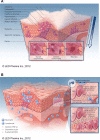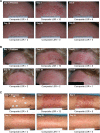New developments in the treatment of actinic keratosis: focus on ingenol mebutate gel
- PMID: 22956883
- PMCID: PMC3430094
- DOI: 10.2147/CCID.S28905
New developments in the treatment of actinic keratosis: focus on ingenol mebutate gel
Abstract
Actinic keratosis is a common disease in older, fair-skinned people, and is a consequence of cumulative ultraviolet exposure. It is part of a disease continuum in photodamaged skin that may lead to invasive squamous cell carcinoma. Treatment options frequently used include cryosurgery and topical pharmacologic agents, which are examples of lesion-directed and field-directed strategies. Ingenol mebutate gel was recently approved by the US Food and Drug Administration for topical treatment of actinic keratosis. While the mechanism of action of ingenol mebutate is not fully understood, in vitro and in vivo studies using tumor models indicate it has multiple mechanisms. Ingenol mebutate directly induces cell death by mitochondrial swelling and loss of cell membrane integrity preferentially in transformed keratinocytes. It promotes an inflammatory response characterized by infiltration of neutrophils and other immunocompetent cells that kills remaining tumor cells. The ability of ingenol mebutate to eliminate mutant p53 patches in ultraviolet-irradiated mouse skin suggests that it may have the potential to treat chronically ultraviolet-damaged skin. In human studies, ingenol mebutate achieved high clearance of actinic keratosis on the head and body after 2-3 consecutive daily treatments when measured by complete or partial clearance of lesions. Localized inflammatory skin responses were generally mild to moderate and resolved in less than a month.
Keywords: actinic keratosis; field therapy; ingenol mebutate gel; nonmelanoma skin cancer; protein kinase C delta.
Figures





Similar articles
-
Clinical findings using ingenol mebutate gel to treat actinic keratoses.J Am Acad Dermatol. 2013 Jan;68(1 Suppl 1):S39-48. doi: 10.1016/j.jaad.2012.09.050. J Am Acad Dermatol. 2013. PMID: 23228305
-
Randomized, double-blind, double-dummy, vehicle-controlled study of ingenol mebutate gel 0.025% and 0.05% for actinic keratosis.J Am Acad Dermatol. 2009 Jun;60(6):934-43. doi: 10.1016/j.jaad.2009.01.008. J Am Acad Dermatol. 2009. PMID: 19467365 Clinical Trial.
-
Pharmacokinetic and pharmacodynamic evaluation of ingenol mebutate for the treatment of actinic keratosis.Expert Opin Drug Metab Toxicol. 2018 Sep;14(9):911-918. doi: 10.1080/17425255.2018.1508449. Epub 2018 Aug 9. Expert Opin Drug Metab Toxicol. 2018. PMID: 30074409 Review.
-
Exploring the use of ingenol mebutate to prevent non-melanoma skin cancer.Dan Med J. 2017 Nov;64(11):B5368. Dan Med J. 2017. PMID: 29115209
-
Ingenol mebutate gel 0.015% and 0.05%: in actinic keratosis.Drugs. 2012 Dec 24;72(18):2397-405. doi: 10.2165/11470090-000000000-00000. Drugs. 2012. PMID: 23231025 Review.
Cited by
-
Tolerability and Pharmacokinetics of Ingenol Mebutate 0.05% Gel Applied to Treatment Areas up to 100cm(2) on the Forearm(s) of Patients with Actinic Keratosis.J Clin Aesthet Dermatol. 2014 Dec;7(12):19-29. J Clin Aesthet Dermatol. 2014. PMID: 25584134 Free PMC article.
-
Jatrophane Diterpenoids from the Seeds of Euphorbia peplus with Potential Bioactivities in Lysosomal-Autophagy Pathway.Nat Prod Bioprospect. 2021 Jun;11(3):357-364. doi: 10.1007/s13659-021-00301-4. Epub 2021 Mar 14. Nat Prod Bioprospect. 2021. PMID: 33719014 Free PMC article.
-
Assessing Specialized Metabolite Diversity in the Cosmopolitan Plant Genus Euphorbia L.Front Plant Sci. 2019 Jul 2;10:846. doi: 10.3389/fpls.2019.00846. eCollection 2019. Front Plant Sci. 2019. PMID: 31333695 Free PMC article.
-
Biomarkers of Cellular Senescence and Skin Aging.Front Genet. 2018 Aug 23;9:247. doi: 10.3389/fgene.2018.00247. eCollection 2018. Front Genet. 2018. PMID: 30190724 Free PMC article. Review.
-
New Insights on Euphorbia dendroides L. (Euphorbiaceae): Polyphenol Profile and Biological Properties of Hydroalcoholic Extracts from Aerial Parts.Plants (Basel). 2021 Aug 6;10(8):1621. doi: 10.3390/plants10081621. Plants (Basel). 2021. PMID: 34451666 Free PMC article.
References
-
- Drake LA, Ceilley RI, Cornelison RL, et al. Guidelines of care for actinic keratoses. Committee on Guidelines of Care. J Am Acad Dermatol. 1995;32(1):95–98. - PubMed
-
- Society for Investigative Dermatology, American Academy of Dermatology Association. The burden of skin diseases, 2005. Available from: http://www.lewin.com/~/media/lewin/site_sections/publications/april2005s.... Accessed March 12, 2012.
-
- Cockerell CJ, Wharton JR. New histopathological classification of actinic keratosis (incipient intraepidermal squamous cell carcinoma) J Drugs Dermatol. 2005;4(4):462–467. - PubMed
-
- Berman B, Bienstock L, Kuritzky L, Mayeaux EJ, Jr, Tyring SK. Actinic keratoses: sequelae and treatments. Recommendations from a consensus panel. J Fam Pract. 2006 May;55(Suppl 5):1–8. - PubMed
-
- Schwartz RA. The actinic keratosis. A perspective and update. Dermatol Surg. 1997;23(11):1009–1019. - PubMed
LinkOut - more resources
Full Text Sources
Other Literature Sources
Medical
Research Materials
Miscellaneous

